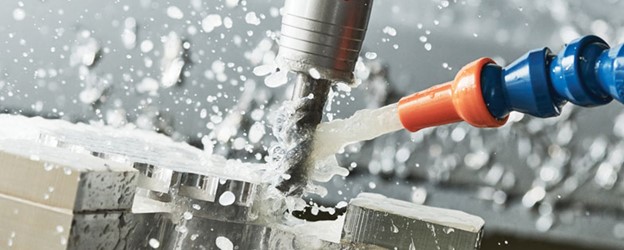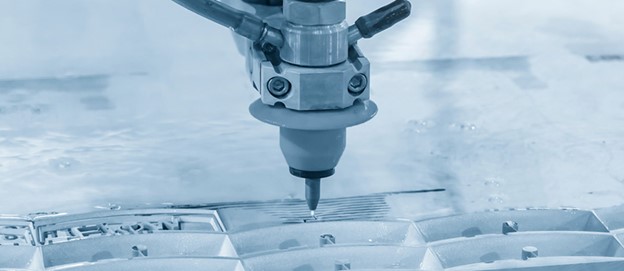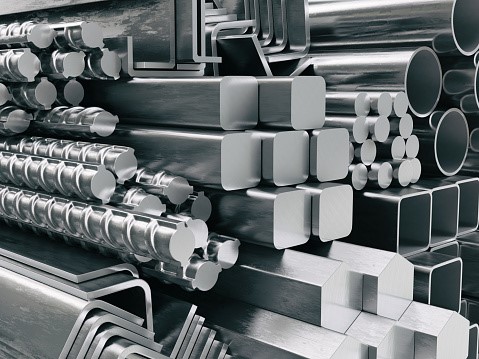Waterjet cutting is a relatively new cutting method, yet it is highly popular in several manufacturing industries. Its popularity is due to several reasons, and the commonest reason businesses choose it over other cutting methods is its tight tolerance. Under the strictest use, waterjet cutting tolerances can reach +/- 0.001″, making the process the most accurate cutting process in manufacturing. This article extensively discussed waterjet cutting tolerance and why you need it.
Why Is High Precision Waterjet Cutting Important?

Precision and accuracy are important parts of every manufacturing process and come with the need for low tolerance. Precise waterjet cutting is very important in industries such as aerospace and automotive part manufacturing, due to the low tolerance requirement.
In these industries, part manufacturing takes place separately and in segments. As a result, assembly is needed at the later end. When the process calls for a cutting process, waterjet cutting ranks high among the compatible processes as its low tolerance makes it possible to achieve a smooth and seamless cut that aids the easy assembly of different parts.
Not all industries require tight tolerance so you might consider other cutting methods. Nevertheless, waterjet cutting is often the most suitable method when there is a need for high precision, accuracy, and tight tolerances.
Types of Waterjet Cutting Tolerances
Waterjet cutting is highly accurate because of its tight cutting tolerance (i.e., the shift in the actual cut from the intended cut). There are two ways to measure its precision and accuracy:
· Typical cutting tolerances
Waterjet cutting machines have a very low tolerance that you might not see with the naked eye. Generally, waterjet cutters can achieve ± 0.002″ (0.05 mm) to ± 0.001″ (0.025 mm).
· Optimal cutting tolerances
The optimal is the minimum tolerance you can obtain from a waterjet machine, and it depends on the machine and its manufacturer. Nevertheless, many machines can machine about ± 0.001″ (0.025 mm).
Accuracy Differences Between Abrasive and Pure Waterjet Cutting

Abrasive and pure waterjet cutting are two main types of waterjet cutting processes. Below is the difference in their accuracy.
Abrasive Waterjet Cutting Tolerances
To understand the tolerance from the abrasive jet cutting, you need to understand the process itself. Abrasive waterjets have two nozzles. The first nozzle called the waterjet nozzle, is made from diamond or sapphire due to its strong mechanical properties. Here, the water moves at a very high speed, creating low pressure in the next chamber. As a result of the low pressure, the abrasive material is pulled into the high-speed water and accelerated through a second nozzle. This creates a powerful water beam that can cut through any material.
The cutting tolerance of the abrasive water jet depends on the abrasive material’s speed. However, it can achieve tolerance up to 0.003″, making it suitable for cutting very hard materials.
Pure Waterjet Cutting Tolerances
In contrast to the abrasive cutting process, pure waterjet cutting does not contain any abrasive. As a result, it has lower cutting power. Nevertheless, it is applicable in cutting soft materials such as foams. Furthermore, it has high precision as it can reduce the cutting gap width to just 0.08 mm. This allows operators to cut parts with complex geometries.
Factors That Affect Waterjet Cutting Accuracy
We will explore these factors in detail and discuss how they can impact the cutting tolerance in waterjet cutting. By understanding the various factors, you can optimize your waterjet cutting process and produce high-quality parts that meet your required specifications and standards.
· Cutting Speed
The cutting speed is a major determinant. Operating the machine at a fast-cutting speed will reduce the waterjet accuracy, leading to a higher tolerance. However, being too slow can render the process inefficient.
As a result, you should be able to decide on a better cutting speed depending on the material you are working on and the level of productivity desired.
· Material Thickness
The thickness of the part you want to cut can determine the tolerance associated with the process. Generally, it is difficult to control the water beam when working with thick materials, and here, it can lead to a blowout in the corners or the formation of tapers around the curves.
The type of taper formed depends on the thickness with thin material about 1/8″ tending to form V-shaped taper while thicker ones form barrel taper.

· Material Hardness
Material hardness is important in many manufacturing processes. Hard materials have lesser taper determines the tolerance. Therefore, you should adjust the cutting speed or tilt the cutting head to the opposite of the taper direction. Furthermore, hard materials are hard to cut. As a result, the process requires that the material is softer than the abrasive materials.
· Stability of Working Table
An unstable working table can lead to the generation of vibration, affecting the cutting process’s precision and tolerance. Nevertheless, there are several developments in terms of reducing vibration. For example, some hardware can function in unstable conditions due to lower susceptibility to vibrations. However, if the cutting head vibrates relatively while the part is stable, the cutting will be less precise. You can reduce vibration by properly fixing the material on the working table.
· Cutter Condition
The cutter condition is also an important factor. You can have better accuracy when the cutter is properly maintained, unlike a poorly maintained machine with worn-out nozzles or unreplaced spare parts.
You can improve the cutter condition by following the machine maintenance tips. Furthermore, you should replace worn-out parts as prescribed by the manufacturer.
· Positioning Accuracy
This denotes the precision and repeatability of positioning the abrasive jet head. On the X-Y cutting table. The easier achieving such accuracy, the easier the ability to achieve tight tolerance and the more the machining precision. For example, a positional accuracy of 0.001″ (0.025 mm) can lead to a part accuracy of 0.005″ (0.12 mm).
· Controller System
It is important to use the latest controller technology for better accuracy. Using the latest control system can help handle hard and thick materials easier. This is evident in how newer/advanced waterjet cutting machines can handle such materials, unlike the older machines.
· Operator Skills
Operator skills come about in the understanding of the process and its intricacy. For example, a learned operator would know a project’s effective and efficient cutting speed and when to change it. Furthermore, they can easily troubleshoot errors and maintain tolerance during cutting.
· Software
The software determines the machine’s positional accuracy. Therefore, you should consider using a machine with newer and tested software.
Comparing Waterjet Cutting Tolerances to Other Processes
Compared to other cutting processes, such as laser cutting, waterjet cutting offers a highly accurate tolerance. A major reason for this is that the cutting head does not touch the workpiece. This is unlike other cutting processes, which increase the part temperature during cutting and reduce the tolerance.
With the process, achieving a 0.0015″ cut is possible, making it the method of choice for many industrial parts. This is compared to other processes according to the list below:
| Cutting Techniques | Tolerance (inches) |
| Waterjet cutting | ±0.001 |
| Laser cutting | ±0.005 |
| EDM cutting | ±0.0001″ |
| Oxy-fuel cutting | ±0.06 |
| Plasma cutting | ±0.02 |
Make Waterjet Cuts With Tight Tolerances
Waterjet cutting tolerance determines the accuracy of the cutting machine and the suitability of the process for parts with complex designs. As a result, it’s best to choose the right service for your precision waterjet cut parts. Do you need a hand? RapidDirect is a Chinese-based rapid prototyping process that renders waterjet cutting services, among other manufacturing services.
We render our services to several industries, companies, and OEMs and can provide prototypes and parts with high tolerance requirements thanks to our state-of-the-art facilities, machines, and dedicated engineering team. We are a step ahead in quality assurance and control as our inspection control team ensures high-quality and high-precision waterjet cut parts.
Visit our online quotation platform and upload your CAD files to get an instant quotation and an automated DfM report. Furthermore, you can manage your order and track the cutting process until delivery! All these are at a competitive price and have a fast lead time.
Differences Between Positioning Accuracy and Tolerance of Waterjet
Positional accuracy is how easily, precisely, and reproducible you can position the cutting head on an X-Y table. On the other hand, tolerance in waterjet is the permissible limit in variation during the cutting process. A reproducible positioning accuracy will lead to a tight tolerance, while improper positioning of the cutting machine will lead to a high tolerance.
As a result, you should consider the machine, the quoted tolerance, and the quoted positioning accuracy of the mechanics of the machine. Understanding these will ensure you achieve the desired cutting accuracy in the final parts.
Conclusion
The waterjet cutting process dominates in several industries due to its material compatibility, heat generation, and, more importantly, its tolerance. The waterjet cutting has accurate tolerance, making it the most accurate process. This article discussed the several factors that affect tolerance so that you can effectively decide whether it is the right one for your project.
FAQs
Yes, the success of a cutting process depends on tolerance. However, tolerance also depends on the project. As a result, you should only take cutting tolerance into account when the project requires very high precision, as seen in automotive and aerospace part manufacturing, a precision of a fraction of a millimeter.
Kerf is the amount of material removed from the part while cutting, and it is a positive number. On the other hand, cutting tolerance is how much the actual cut shifted from the intended cut, which can be a positive or negative number.
No, there is no cutting process with zero cutting tolerance. Every process has a certain degree of tolerance. However, the waterjet cutting tolerances are the lowest (almost negligible) when compared to other cutting methods.


